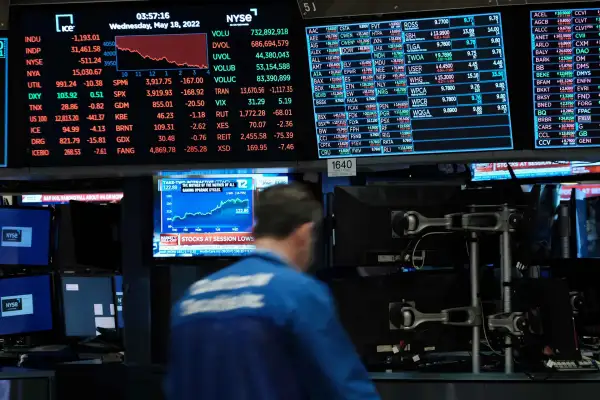Stocks Are on the Brink of a Bear Market. What Should Investors Do Now?
Money is not a client of any investment adviser featured on this page. The information provided on this page is for educational purposes only and is not intended as investment advice. Money does not offer advisory services.

The S&P 500 is very close to a bear market, and your portfolio is likely feeling the pain. Just how bad are things going? And what, if anything, should investors do to adjust for a bear market?
On Wednesday, the S&P 500 — an index commonly used to measure the stock market overall — fell 4%. That's the largest one-day drop since 2020, placing the index at 18% below its January high. To enter a bear market, the S&P 500 would need to plummet to 20% below its last high.
The index is teetering on the edge of a bear market, and investors are understandably worried amid major selloffs in recent weeks.
The Dow Jones Industrial Average suffered its worst selloff in nearly two years on Wednesday, and the Nasdaq Composite fell 4.7%. Stocks and other financial assets, like cryptocurrency, have been struggling as the Federal Reserve hikes interest rates in an effort to control rising inflation. Disappointing quarterly earnings reports from Target and Walmart added to the pressure this week, as the retailers reported grappling with rising costs. The stock prices of both companies fell steeply after the earnings were reported.
"This feels extremely uncomfortable because of how spoiled we were," says Ryan Detrick, chief market strategist at LPL Financial, in light of the way the market doubled in value from its March 2020 low to the summer of 2021 and the relative ease with which investors could make money over the last few years.
But discomfort doesn't mean you should switch up your investing strategy. Here's what to know.
How likely is a bear market?
With the market being down around 18% now, it's certainly not a stretch to say we could end up in a bear market, says Sam Stovall, chief investment strategist at CFRA Research. Looking at the technicals and fundamentals of the S&P 500, it's reasonable to assume the market could be heading there, he adds.
"Bear markets are natural occurrences in the stock market," he adds.
In fact, there have been 17 bear or near bear markets since World War II, according to data from LPL Financial, with the most recent one starting in February of 2020 and lasting about one month. The average drop, the firm says, was nearly 30% and lasted nearly a full year.
"One more bad big down day and we're there so it's quite likely it could happen," Detrick says.
Why you shouldn't panic about a potential bear market
Instead of noting how far the market falls, pay attention to how quickly it tends to recover, Stovall says.
If the S&P 500 doesn't move lower than it is now — which is considered a correction, or a drop of between 10% and 20% from the last record high — history tells us we could recover what's lost in four months.
Even if we do fall into a bear market, remember: We won't stay there. Historically, bear markets of less than 40% tend to take about 14 months to break even, Stovall says.
"If you don't have 14 months to get back to breakeven, you should not be invested in equities," he adds.
While a little more weakness in the stock market is "probable," Detrick says he doesn't see this spiraling into a situation like the dot-com bubble or the financial crisis of 2008 when the stock market was nearly cut in half.
We could be close to a major low right now, Detrick says, and six to 12 months from now stocks will "probably be a good deal higher."
What should investors do now?
While the news headlines and seeing red on your trading apps may be scary, remember that you haven't actually lost money until you sell, says Jon Ulin, a certified financial planner and CEO of Ulin & Co. Wealth Management in Boca Raton, Florida. When stocks are sliding, you don't want to panic sell and lock in losses.
Instead of panicking, use this period of market volatility as a time to review your investment portfolio, Ulin adds. Financial advisors recommend regularly rebalancing your portfolio. In other words, you should periodically sell investments that have grown in value and replenish investments that have fallen in value to get your portfolio back to holding its target weights.
Financial experts recently told Money about three other investing moves you can make when markets are volatile: Ensure you have an emergency fund, consider tax-loss harvesting and start dollar-cost averaging.
If you're tempted to try to time the market and buy the dip, it may be wiser to instead engage in dollar-cost averaging. This involves investing modest amounts of money at regular intervals, like $100 every month. It's an especially good strategy to consider, as it will ensure you're invested in the market on its best days.
If you opt to do nothing as the stock market hovers close to a bear market, that's okay too. Actually, it's probably for the best. If you have a well-diversified portfolio with a mix of stock, bonds and cash that is appropriate for your risk tolerance, timeline and goals, financial advisors say your best move is likely to stay the course and wait for the markets to recover.
More from Money:
4 Investing Moves to Make Instead of Panicking About Volatile Markets
3 Reasons Investors Should Avoid Reacting to Stock Market Volatility


